Gulf Tower: A Landmark of Dubai's Architectural Landscape
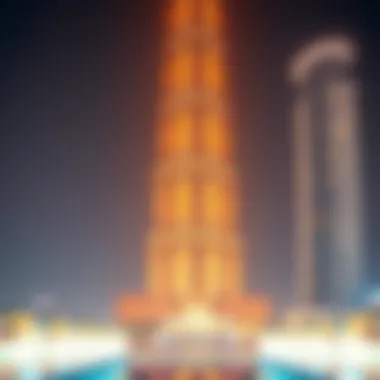
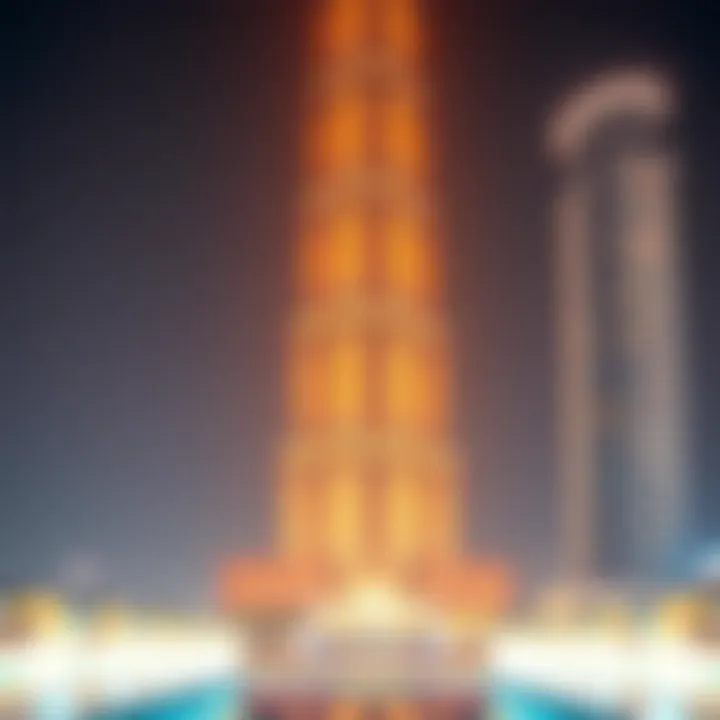
Intro
The Gulf Tower is more than just another addition to Dubai's architectural tapestry; it is a testament to progress and innovation in a city renowned for its striking skyline. As we peer into its design philosophy, we uncover a story interwoven with the pulse of urban development and the economics that underpin it. This article aims to dissect its multifaceted nature, shedding light on how it has influenced market trends and investment opportunities in one of the world's most vibrant property markets.
From awe-inspiring heights to the delicate details of its design, Gulf Tower serves as a beacon for real estate investors, urban planners, and those simply captivated by architectural beauty. This exploration does not merely scrape the surface. Instead, it brings forth a comprehensive narrative that dives deep into the core of what makes this structure a landmark.
As we move forward, we'll tackle how the dynamics of shifting markets play into the Gulf Tower's significance, allowing potential buyers and investors to maneuver with confidence. Interested parties will find rich insights into current real estate pricing trends and the evolving neighborhoods that surround this architectural marvel, further emphasizing its role as a harbinger of opportunity.
So, sit tight as we embark on this detailed journey through the Gulf Tower, one brick at a time, illuminating its historical context, architectural brilliance, and the sociocultural implications that ripple across Dubai's urban landscape.
Foreword to Gulf Tower
Choosing to focus on Gulf Tower is like opening a door to an intricate world where architecture meets the essence of Dubai. This tower isn't just a building; it has become a symbol of the city's rapid development and ambition over the last few decades. To neglect discussing Gulf Tower would be akin to avoiding the heartbeat of the metropolis itself.
Overview of Dubai's Architectural Landscape
Dubai is often described as a portrait of modernity painted against a canvas of tradition. The architectural landscape here is a melting pot of styles, cultures, and innovations, where each structure tells a different story. From the futuristic lines of the Burj Khalifa to the traditional squat structures in Dubai's old town, every building has its own unique narrative. Gulf Tower fits seamlessly into this intricate tapestry, showcasing how cutting-edge design and functionality can converge. With structures reaching for the heavens and others embedded in rich history, Dubai stands as a testament to human prowess and creativity in the architectural domain.
Significance of Gulf Tower
Gulf Tower's significance goes beyond its striking design and towering stature. It serves as a nexus for various activities—residential, commercial, and leisure—which makes it a microcosm of urban life in Dubai. The tower embodies the aspirations of not just investors, but also of residents and expatriates who dream of being part of this vibrant community.
Furthermore, its strategic location and modern amenities contribute to its allure. Gulf Tower isn't merely an architectural feast; it stands as an economic engine stimulating growth in the surrounding areas. Investors often see it as a benchmark for real estate trends and development opportunities in the region. In light of all this, Gulf Tower is not simply a structure; it is a beacon of progress and ambition, deserving of detailed exploration.
Architectural Design and Features
The architectural design of Gulf Tower encompasses more than just aesthetics; it embodies a vision for urban living, blending functionality with elegance. This section will discuss the significant aspects of architectural design and features that make Gulf Tower a remarkable addition to Dubai's skyline. From its innovative design philosophy to the materials employed and sustainability initiatives, these elements collectively enhance its value in the real estate landscape.
Design Philosophy
Gulf Tower's design philosophy marries modernism with cultural resonance. It is a beacon of contemporary architecture that reflects the ambitions of Dubai. The tower’s silhouette is sculpted to echo the desert's dunes, providing an organic feel amidst the urban sprawl.
The architects aimed to create a tower that doesn't just stand tall but tells a story. Spaces within have been meticulously planned to foster community through shared amenities, while also allowing for individual expression through customizable interiors. This approach not only enhances the living experience but also supports a vibrant lifestyle, making Gulf Tower appealing to investors looking for premium real estate opportunities.
"The design of Gulf Tower isn't just about height; it's about heightening experiences."
Materials Used
The choice of materials in Gulf Tower speaks volumes about its commitment to quality and longevity. The outer façade, comprising high-performance glass and natural stone, is designed to withstand Dubai's harsh climate while offering breathtaking views. This blend ensures the structure remains striking yet practical.
Several layers of insulation and energy-efficient glazing minimize heat gain, thereby lowering energy consumption, which is crucial in a city characterized by soaring temperatures. The use of locally sourced materials further imbues the tower with a sense of place, connecting the building to its surroundings and enhancing its market appeal.
Key materials include:
- High-performance glass: Reduces energy costs while providing stunning vistas.
- Natural stone: Adds aesthetic value and durability to the exterior.
- Sustainable composites: Used within interiors for both design and ecological consciousness.
Sustainability Initiatives
Sustainability remains at the core of Gulf Tower's architectural design, aligning with Dubai's vision to develop eco-friendly urban spaces. The tower incorporates several green building practices that aim to minimize environmental impact.
Optimizing water usage is critical, and Gulf Tower employs rainwater harvesting systems that supply water for landscaping. Additionally, the building incorporates solar panels on its rooftop, harnessing renewable energy to power common areas, further enhancing its green credentials.
The commitment to sustainability not only contributes positively to the environment but also increases the property’s desirability. Investors can expect greater returns on properties like Gulf Tower as global consciousness shifts towards sustainable living.
Some initiatives include:
- Rainwater harvesting: Efficient water management in the desert environment.
- Solar energy utilization: An innovative approach to meet energy needs.
- Green spaces: Encouragement of biodiversity within urban areas.
In summary, Gulf Tower’s architectural design and features are rooted in a philosophy that prioritizes aesthetic appeal, functionality, and sustainability. Whether one is an investor, a homeowner, or a tenant, understanding these aspects enriches the appreciation of this iconic structure, cementing its place in Dubai’s architectural lexicon.
Historical Context
Understanding the historical context surrounding the Gulf Tower is crucial in appreciating its architectural and cultural significance in Dubai. This section explores the timeline of development and the cultural influences that have shaped the Gulf Tower, providing insight into how this structure became a central piece of Dubai’s skyline.
Timeline of Development
The timeline of the Gulf Tower's development offers a glimpse into Dubai's rapid transformation from a small fishing village into a global city. Construction commenced in the early 2010s, coinciding with a period marked by unprecedented growth in real estate and tourism as Dubai emerged as a key player on the international stage.
- 2007: Initial designs of the Gulf Tower were conceptualized by an international team of architects, faced with the challenge of crafting a structure that would blend modernity with the rich cultural heritage of the region.
- 2010: Groundbreaking marked the official start of construction, amid a backdrop of global economic challenges. However, Dubai's determination to innovate persevered.
- 2015: The Gulf Tower reached its structural completion, standing as a testament to modern engineering and architectural prowess. At this point, it was among the tallest structures in the city, capturing the attention of both locals and tourists alike.
- 2018: The final touches were put in place, leading to a grand opening that showcased not only the tower’s height but also the artistic designs that paid homage to Arab culture.
The construction process wasn't without its hurdles. From sourcing sustainable materials to navigating regulatory challenges, every phase of development needed careful consideration. This timeline illustrates how Dubai's commitment to modernity didn't overlook its traditional roots, marking the Gulf Tower as both an architectural feat and a symbol of the nation's aspirations.
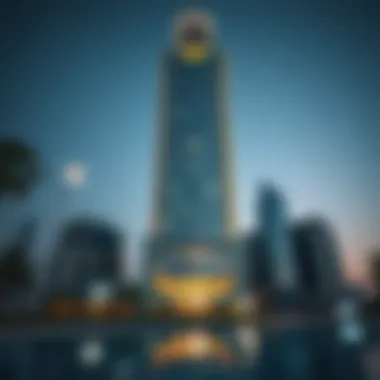
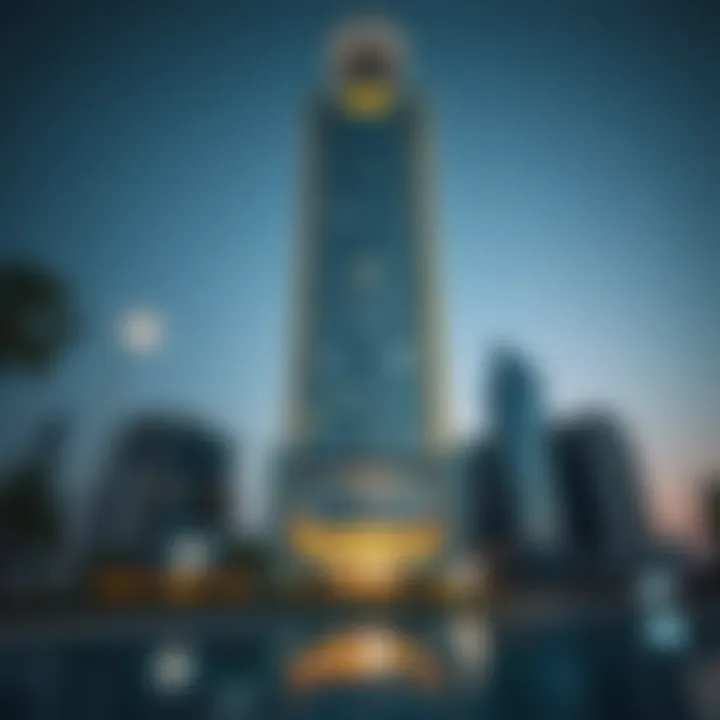
Cultural Influences
Cultural influences are instrumental in the design and function of the Gulf Tower. The intersection of tradition and innovation is at the heart of this landmark's essence.
- Historical Roots: The architectural language of the Gulf Tower draws inspiration from the intricacies of Islamic art and architecture. Features such as mashrabiya - a window with carved wood lattice screens - showcase traditional designs while integrating them into a sleek, modern façade.
- Global Connections: As Dubai becomes a melting pot of cultures due to its diverse expatriate population, the Gulf Tower embraces this multiculturality. It serves not only as residential and commercial space but as a hub for international business, furthering connections beyond the UAE’s borders.
- Community Engagement: The Gulf Tower is strategically positioned to foster community interaction. Public spaces around the tower are designed to host cultural events, art exhibitions, and community gatherings, bridging gaps between different cultures and encouraging social cohesion.
In summary, the historical context of the Gulf Tower is not merely about following a timeline; it’s about understanding the cultural narrative behind its construction. This interplay of influences has not only shaped its architectural identity but also reinforces Dubai's role on the global stage as a center of innovation and cultural exchange.
Economic Impact
The economic ramifications of the Gulf Tower extend well beyond its striking facade; they ripple through various sectors of Dubai's economy. As a symbol of modernity and ambition, Gulf Tower not only attracts tourists but also draws in investors and businesses, significantly shaping the commercial landscape of the city. In this article section, we delve into aspects of investment opportunities and real estate values, revealing how they connect with the broader economic context surrounding the Gulf Tower.
Investment Opportunities
The Gulf Tower has become a focal point for investment in Dubai, welcoming both local and international capital. Its striking architecture and strategic location have created a buzz that investors cannot ignore. Here are some specific elements driving investment interest:
- Commercial Space: The tower offers prime office locations catering to multinational corporations. Businesses looking for a prestigious address find Gulf Tower irresistible, leading to competitive rental rates.
- Mixed-Use Facilities: Investments in mixed-use spaces—integrating residential, commercial, and leisure components—have seen a significant uptick. This encourages not just businesses but also enhances community living.
- Hospitality Sector: With tourism steadily increasing in Dubai, the tower's proximity to attractions encourages investment in hotels and hospitality startups, providing a diverse portfolio for investors.
In essence, Gulf Tower represents an attractive opportunity for those keen on tapping into Dubai's robust economy, making it a goldmine for savvy investors seeking long-term returns.
Real Estate Values
The real estate market surrounding the Gulf Tower reflects the vibrant economic conditions of Dubai. Its influence on property values is undeniable, creating a dynamic ripple effect. Key insights into the real estate values include:
- Appreciation Trends: Properties near the Gulf Tower are experiencing substantial appreciation, making them valuable assets for current homeowners and investors alike. Many believe these trends will only continue to strengthen in the coming years.
- Luxury Market: The tower has catalyzed a surge in luxury developments, attracting affluent buyers. High-end apartments and penthouses are not just residing spaces; they represent status and exclusivity.
- Demand vs. Supply: The high demand for properties within close proximity to the Gulf Tower is contrasted with a limited supply, creating a seller's market. As a result, property prices have been climbing relentlessly, further incentivizing investors.
Property values in the vicinity of Gulf Tower have seen a staggering 30% increase over the last five years, underlining its impact on Dubai's real estate economics.
The economic impact of Gulf Tower thus extends from the nuances of investments to the overarching movements within the real estate market, proving it to be more than just a structure—it is a catalyst for economic growth.
Gulf Tower's Role in Urban Development
The Gulf Tower plays a critical role in shaping the urban development of Dubai, adding not just to the skyline but also impacting various aspects of community life. Its presence denotes a shift in urban planning and architectural ambition, often serving as a catalyst for surrounding economic growth and infrastructural advancements. By examining these elements, we uncover how Gulf Tower is more than just a building; it reflects a vision for a future where urbanization meets communal harmony and economic investment.
Integration with Surrounding Infrastructure
In constructing the Gulf Tower, planners prioritized seamless integration with existing urban infrastructure. This forward-thinking approach means that the Tower is not an isolated entity, but a cornerstone of connectivity within Dubai.
- Roadways and Public Transport: The Gulf Tower's location benefits from well-connected roadways and is positioned near major transit hubs. This accessibility encourages both local and international visitors, thus fostering a vibrant hub of activity.
- Adjacent Developments: The surrounding areas have seen a rise in complementary commercial and residential properties, effectively expanding community spaces and amenities. As businesses flock to the vicinity, the economic adrenaline rush visible in cafes, shops, and recreational areas boosts the overall urban ecosystem.
"An integrated structure like the Gulf Tower can transform an entire neighborhood, suggesting progress that fosters social and economic relationships among its residents and visitors."
- Green Spaces and Infrastructure: It is essential to note that urban planners have embedded green spaces and pedestrian pathways within the surrounding infrastructure. This strategy not only enhances the aesthetic value but also encourages a healthier lifestyle for residents and visitors alike.
Impact on Community Spaces
The impact of Gulf Tower extends into the very fabric of community spaces within Dubai. It serves as a social and cultural epicenter that enriches the city by catering to the needs of diverse demographics.
- Civic Engagement: The Tower often hosts cultural events and festivities that draw residents together, thereby creating opportunities for civic engagement. These events can be significant in fostering a sense of belonging among community members, which is crucial in a cosmopolitan city like Dubai.
- Commercial Opportunities: The development has attracted numerous retailers and service providers, ranging from high-end boutiques to casual eateries. This diverse range promotes local businesses and evolves the community's economic landscape while ensuring residents have access to varied services.
- Public Amenities: With the creation of the Gulf Tower, thoughtful consideration has been given to adding public amenities such as parks, playgrounds, and community centers, facilitating recreational activities and community interaction.
Through such thoughtful integration, Gulf Tower not only stands tall as a landmark but also functions as a pivotal contributor to the socio-economic tapestry of Dubai, encouraging growth that benefits all its inhabitants.
Market Trends Related to Gulf Tower
Understanding the market trends related to Gulf Tower is like peeking through the looking glass of Dubai's real estate dynamic. It's a lens that offers crucial insights into how this architectural jewel influences and is influenced by the broader economic landscape.
Current Real Estate Trends
Currently, the real estate market in Dubai is experiencing a vibrant phase. With the Gulf Tower in the forefront, several trends can be identified:
- Rising Demand for Luxurious Living: The allure of upscale living is drawing in more investors. Gulf Tower, with its elegant design and premium amenities, attracts affluent buyers and expatriates seeking a lavish lifestyle.
- Short-term Rental Market Boom: There’s a noticeable surge in the popularity of short-term rentals, especially among tourists. The Gulf Tower's strategic location within the city makes it an appealing option for short stays, boosting the local economy and creating a buzz in the hospitality sector.
- Technological Integration: The adoption of smart technologies in real estate is on the rise. Properties around the Gulf Tower are increasingly integrating smart home features, enhancing the living experience and attracting tech-savvy investors.
The shift towards a more digitized and luxurious real estate market indicates a changing tide. Investors are keen to find properties that not only offer aesthetic appeal but also high-quality living experiences, making Gulf Tower a critical player in this evolving narrative.
Future Projections
Looking ahead, the Gulf Tower is set to play a pivotal role in shaping future real estate trends. Here’s what experts anticipate:
- Sustained Growth in Property Values: Analysts forecast consistent increases in property values surrounding Gulf Tower. As Dubai continues to garner international attention, the demand for prime properties is expected to escalate.
- Shifts in Demographics: The ongoing influx of diverse nationalities to Dubai signals a shift in demographics, influencing market demand. Gulf Tower, appealing to both expatriates and locals, positions itself as a hub for multicultural living.
- Increased Focus on Sustainability: With a global shift toward sustainability, future developments around Gulf Tower are likely to emphasize environmentally-friendly practices. This not only caters to eco-conscious consumers but could also influence regulations around real estate.
As urbanization continues to evolve, the Gulf Tower stands as a beacon for potential investments. It's more than just a structure; it's a reflection of a city evolving, adapting, and capitalizing on future opportunities.
"In real estate, the only constant is change. The Gulf Tower embodies this philosophy perfectly."
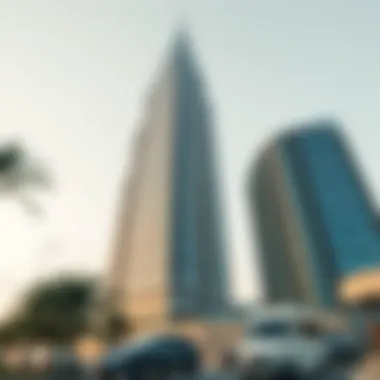
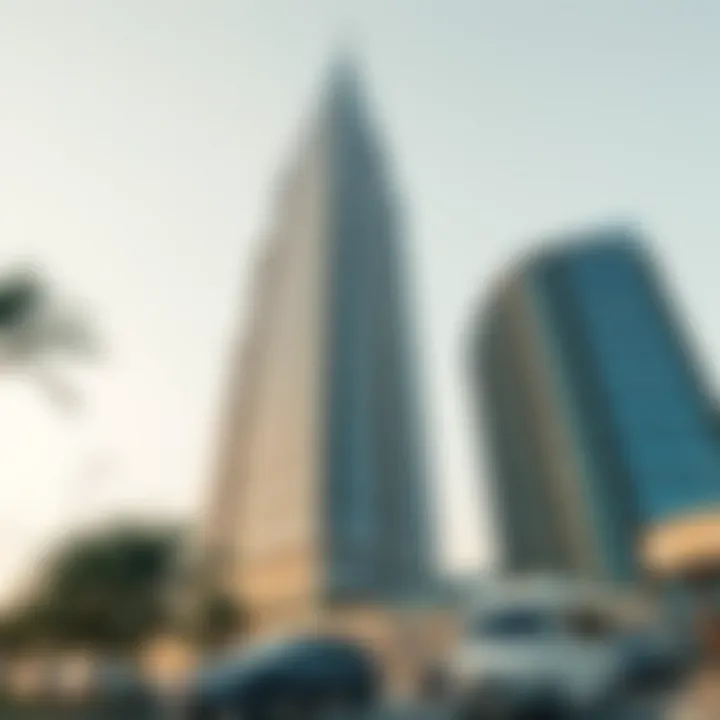
In summary, keeping an eye on the market trends associated with Gulf Tower provides investors, homeowners, and renters with invaluable insights, ensuring they stay ahead of the curve in a competitive marketplace.
For additional information on real estate trends in Dubai, visit Dubai's Real Estate Market Analysis.
Lifestyle Implications
The Gulf Tower is more than a mere structure; it symbolizes a shift in lifestyle, blending luxury and modern convenience within a mesmerizing architectural tapestry. Understanding the lifestyle implications surrounding this iconic edifice invites us to explore how it shapes the day-to-day experiences of its residents and visitors alike. Its stature as a hub of habitation and commerce makes it a focal point for both local and expatriate communities, nourishing the vibrancy of each demographic that calls it home.
Residential Amenities
Living in the Gulf Tower offers myriad residential amenities tailored to enhance comfort and convenience. The tower is fitted with state-of-the-art facilities that cater not just to luxury but practicality as well. From high-tech security systems ensuring safety to spacious fitness centers promoting healthy living, residents enjoy a suite of options that elevate everyday life.
- Concierge Services: Round-the-clock concierge services cater to various needs, be it recommending a local restaurant or arranging transportation, making life seamless for busy individuals.
- Sky Gardens and Pools: With breathtaking views of the Dubai skyline, the shared sky gardens offer a tranquil escape from the bustling city below. Residents can unwind by the infinity pools while soaking in the sun.
- Community Spaces: Designed to foster interactions among residents, ample community spaces encourage socialization and cultivate a sense of belonging within the diverse population.
The sprawling residential units typically include modern kitchens equipped with top-notch appliances and stylish bathroom finishes—all crafted with quality in mind. Therefore, living in the Gulf Tower feels less like a residence and more like an integrated lifestyle package.
Accessibility and Transportation
Accessibility is a crucial aspect that defines the Gulf Tower's appeal, prominently placing it within a well-connected web of transport options. The tower's strategic location enables residents to navigate the city effortlessly, whether they rely on personal vehicles or public transport.
- Proximity to Major Highways: Located near key roads such as Sheikh Zayed Road and Al Khail Road, the Gulf Tower allows for easy commuting to various business districts and leisure spots across Dubai.
- Public Transport: The nearby metro stations, along with multiple bus routes, ensure that residents have access to efficient and economical travel methods, reducing reliance on private cars and easing traffic congestion.
- Ride-hailing Services: Plentiful ride-hailing options provide an easy solution for those occasions when residents prefer not to drive, making for a hassle-free experience when exploring the city or heading to meetings.
"Accessibility isn't just about convenience; it's about the ability to live one's life fully without the constraints of distance or time."
Living in close proximity to essential services like supermarkets, schools, and medical facilities further emphasizes the Gulf Tower's location advantages. As a result, it cultivates a lifestyle that balances modern living with an appreciation for the luxuries afforded by attentive design and strategic planning.
Challenges in Construction and Maintenance
The construction and maintenance of the Gulf Tower present a myriad of challenges, reflecting the complexities inherent in creating skyscrapers of such ambition and scale. These difficulties are not simply technical; they also encompass regulatory, environmental, and logistical considerations. Addressing these challenges is imperative, as it directly impacts the tower's longevity and functionality, as well as the safety and comfort of its occupants.
Technical Hurdles
Creating a towering architectural icon like the Gulf Tower involves several technical challenges that must be meticulously managed. The foremost among these is structural integrity. Given the height of the tower, it must be designed to endure harsh winds and seismic activities typical in the region. The engineering teams incorporate advanced materials and innovative construction techniques, ensuring that the framework is resilient yet flexible.
Key considerations in overcoming technical hurdles include:
- Geotechnical Analysis: Understanding the soil composition and stability before laying foundations is crucial. This requires extensive study and testing, ensuring that the skyscraper does not settle unevenly.
- Height and Wind Resistance: Wind tunnel testing is often conducted to see how the tower interacts with air movement. Adjustments in design may be necessary based on these findings.
- Construction Technology: Utilizing cutting-edge cranes and robotic construction technologies can help streamline the building process while maintaining precision.
Detailed project management techniques must be employed to coordinate the various trades involved in construction, from electrical systems installation to HVAC setups. Failure to properly address these technical hurdles can lead to significant delays and increased costs.
Regulatory Issues
Navigating the labyrinth of regulations surrounding the construction of a skyscraper like the Gulf Tower is another significant challenge. Building codes vary by region, and Dubai’s regulations can be particularly stringent, aimed at ensuring safety, aesthetics, and environmental sustainability.
A few of the major regulatory considerations include:
- Zoning Laws: These dictate where the tower can be erected and its height, ensuring that it fits into the urban landscape seamlessly. Local authorities work closely with developers to ensure compliance.
- Environmental Regulations: Compliance with environmental standards is necessary to minimize ecological footprints. For instance, assessments related to energy consumption and waste management must be conducted.
- Safety Standards: Construction must align with safety regulations, which include everything from fire safety measures to accessibility requirements for individuals with disabilities.
Public engagement plays a vital role in the regulatory process too. Stakeholder meetings can help to ensure that community concerns are addressed, although this can extend timelines and require sensitive negotiations.
Given the significance of the Gulf Tower, overcoming these challenges in construction and maintenance is paramount to ensuring its status as a landmark in Dubai's evolving skyline. Addressing these technical and regulatory challenges head-on can pave the way for successful completion and sustainable operation long into the future.
Comparative Analysis with Other Landmarks
In the realm of architectural significance, comparing the Gulf Tower to other notable structures provides a glimpse into its unique role within Dubai’s evolving skyline. This analytical lens offers insights into design philosophies, cultural resonance, and economic effects that shape perceptions of these towering giants, making it crucial to this article.
Gulf Tower vs. Burj Khalifa
The Burj Khalifa, often hailed as the tallest building in the world, stands as a benchmark against which many structures, including the Gulf Tower, are measured.
- Height and Scale: While the Gulf Tower commands attention in its own right, the Burj Khalifa dwarfs it with a staggering height of 828 meters. This sheer size contributes to its global recognition.
- Design Intent: The Burj Khalifa's design is a blend of modern and Islamic architecture, whilst Gulf Tower leans towards a more contemporary aesthetic that reflects Dubai’s rapid modernization. The artistic choices made during the Gulf Tower's construction emphasize accessibility and functionality, catering more to urban lifestyles.
- Visitor Experience: When it comes to attracting tourists, the Burj Khalifa has the upper hand due to its observation decks that offer panoramic views of the city. The Gulf Tower, however, is designed for residential use, integrating amenities that cater to occupants rather than tourists.
Comparative Insight: Both structures signify Dubai’s architectural ambition, but they do so under different auspices. The Burj Khalifa symbolizes height and global appeal, while the Gulf Tower resonates more with urban integration and local community.
Gulf Tower vs. Other Notable Structures
Focusing on other nearby structures strengthens the understanding of Gulf Tower's position within not just Dubai, but a growing global context. Comparisons can be drawn with landmarks such as the Shanghai Tower and the One World Trade Center.
- Cultural Representation: The Shanghai Tower embodies modern Chinese aspirations, characterized by its twisting form that symbolizes energy and dynamism. In contrast, the Gulf Tower's design reflects the Middle Eastern values of hospitality and community engagement.
- Environmental Considerations: Similar to Gulf Tower, the One World Trade Center in New York incorporates sustainable architecture, but is more focused on memorializing a tragic history. The Gulf Tower, on the other hand, emphasizes forward-thinking environmental strategies in a locale where sustainability is becoming increasingly vital.
- Functionality: Whereas the other structures often serve mixed or purely commercial purposes, the Gulf Tower is intricately tied to community living, enhancing social interaction among residents through thoughtfully integrated public spaces and amenities.
"Each building tells a story, but understanding their narratives enriches appreciation for their roles in the urban narrative."
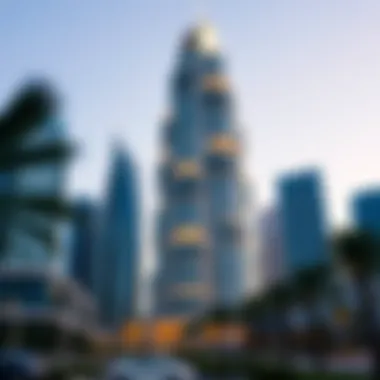
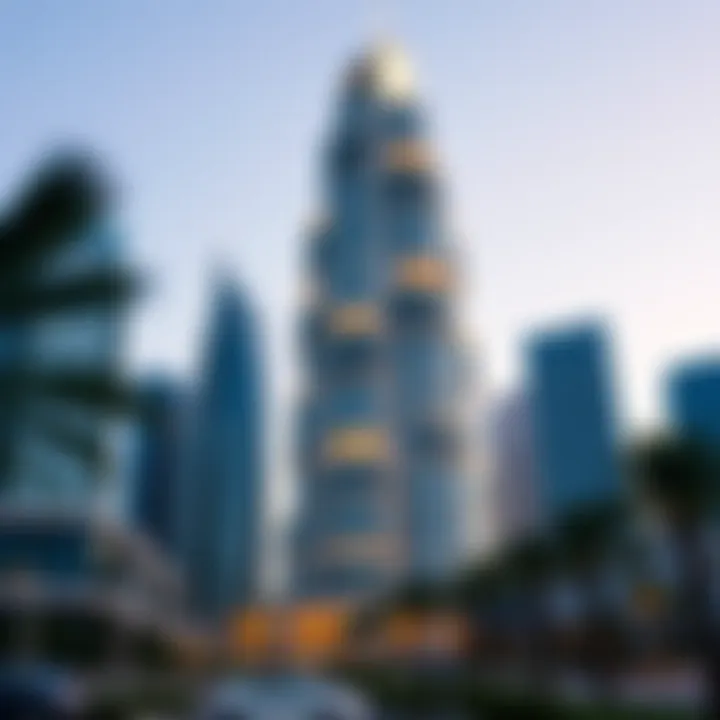
This comparative analysis illustrates that while the Gulf Tower may not reach the same heights as its global counterparts, it stands tall within its own context, significant to the city’s identity and progression. By examining such contrasts, investors and residents alike can appreciate the diverse motivations that inspire urban growth and development.
Gulf Tower's Influence on Tourism
The Gulf Tower stands as a testament to Dubai's ambition, drawing visitors from around the world. Its architectural elegance and strategic location play a vital role in shaping the tourism narrative for this dynamic city. The influence of Gulf Tower on tourism goes beyond mere aesthetics; it intertwines with the cultural fabric and economic drivers of the area.
Attracting Tourists
Tourism is at the heart of Dubai's economy. Attractions like the Gulf Tower entice travelers not only for their visual appeal but also for the experiences they promise. Its impressive height and modern design contribute to a skyline that has become synonymous with luxury and innovation.
As an architectural marvel, Gulf Tower is often featured in travel itineraries and social media feeds, showcasing its visual appeal. Consider the follow points that elucidate its role in attracting tourists:
- Instagramability: The striking architecture combined with stunning sunset views creates a must-snap spot.
- Cultural Significance: Beyond being a pretty face, the tower symbolizes Dubai's growth and ambition, attracting tourists interested in the narrative of the city's rapid evolution.
- Accessibility: Located in a prime area, it serves as a hub for various tourist activities, making it easy for visitors to include it in their agendas.
According to statistics from Dubai Tourism, structures such as the Gulf Tower have a significant impact on visitor rates, making them pivotal in shaping the travel landscape. Just as an oak tree provides shade, Gulf Tower offers visitors a key focus point amidst the vibrant cityscape.
Events and Activities
Gulf Tower is not just a sight to see; it’s a lively center for a plethora of events and activities that elevate its role in the tourism sector. These engagements range from cultural festivals to art exhibitions, providing rich experiences for tourists while driving local participation.
- Cultural Festivals: Hosting events that showcase local culture and traditions encourages tourists to delve deeper into the heritage of Dubai.
- Art Exhibitions: Collaborative events with local artists can attract art enthusiasts, giving the tower a cultural dimension that appeals to diverse visitors.
- Corporate Events: With facility offerings for meetings and conferences, Gulf Tower attracts business travelers. This segment contributes markedly to hotel bookings and entertainment venues in the vicinity.
"The Gulf Tower is not merely a structure but a cornerstone of experience, drawing in tourists with its dynamic events and rich cultural exchange."
With all these elements combined, it's clear that Gulf Tower plays a significant role in enhancing the visitor experience, ensuring that Dubai remains a vibrant tourism hub. By creating a seamless blend between architecture, culture, and communal space, Gulf Tower establishes itself as more than just a point on a map; it becomes an experience that lingers in the minds of its visitors.
Expert Opinions
The insights of experts play a pivotal role in understanding the multifaceted significance of the Gulf Tower. In a landscape as dynamic and rapidly-changing as Dubai's, the perspectives of architects and real estate analysts bring clarity and depth to discussions regarding this architectural marvel. Their opinions not only shed light on design intricacies but also encapsulate broader economic implications.
Architectural experts, in particular, are positioned to dissect the genius behind the Gulf Tower's design philosophy. They can discuss how the structure reflects cultural narratives and the ambition ingrained in Dubai's skyline. These professionals often articulate the aesthetic choices embedded in the building’s features and what they signify in the context of Dubai’s urban evolution. For investors, their insights might inform decisions on viability and future appreciation of property values within this competitive market.
Similarly, real estate analysts offer crucial evaluation of market trends surrounding Gulf Tower. They can quantify the effect of such iconic buildings on local and foreign investments, analyzing how the presence of the tower influences nearby developments and property prices. Their data-driven assessments are invaluable for individuals navigating the complexities of real estate investment in Dubai.
"The Gulf Tower is not just a building; it’s a beacon of modernity that offers a glimpse into the future of urban living in the region."
– An Architect's Perspective
Thus, tapping into expert opinions serves multiple functions: it enriches understanding, enhances decision-making, and ultimately paves the way for informed investments.
Interviews with Architects
Engaging with architects who contributed to the Gulf Tower's creation illuminates the building's artistic vision and engineering marvel. Their narratives offer an insider look into the collaborative process that defines modern architecture. By examining their motivations, one can understand the fusion of functionality and aesthetic appeal that characterizes the Gulf Tower.
Much can be learned from exploring the innovative design elements introduced by these architects. Their comments often reveal the balance they sought between respecting cultural heritage and embracing cutting-edge technology. For instance, architects might discuss how local climate conditions dictated material use and structural decisions.
Moreover, personal anecdotes can surface, reflecting the challenges and triumphs faced during the project’s lifespan. Listening to their experiences provides context that enhances appreciation of the Gulf Tower not just as a building, but as a symbol of dedication and architectural achievement.
Insights from Real Estate Analysts
Real estate analysts dissect the economic impact associated with the Gulf Tower and its surroundings. Their expertise extends beyond mere valuation; they analyze how the building adds or alters the existing urban fabric.
These professionals often track trends such as:
- Investment influx: How the Gulf Tower attracts international investors and contributes to Dubai’s status as a global business hub.
- Socioeconomic changes: The effects on local demographics due to rising property values and the influx of affluent residents.
Analysts might use empirical data and forecasting models to present a clear picture of demand in urban areas surrounding the tower. Their projections can inform potential investors about the likely appreciation of real estate assets, impacting purchasing decisions significantly.
In essence, the combination of insights from architects and real estate professionals fosters a comprehensive outlook on the Gulf Tower, allowing for a nuanced appreciation of its role in shaping Dubai's skyline and economy.
Culmination
Summarizing the Legacy of Gulf Tower
The Gulf Tower stands as a sentinel of modernity within the dynamic landscape of Dubai. Its legacy is not simply measured in height or architectural prowess; it encapsulates the converging tales of ambition, innovation, and cultural significance. This skyscraper represents a commitment to pushing the envelope—a physical manifestation of Dubai's soaring aspirations. It symbolizes the capabilities of contemporary engineering and design, showcasing an intricate blend of form and function that caters to both aesthetic appreciation and practical utility.
Through the years, the Gulf Tower has been more than just a building; it has become a landmark—a pivot around which the city’s identity spins. The architect's design choices, which marry traditional influences with cutting-edge techniques, invite both residents and tourists alike to admire its beauty.
Moreover, the development around Gulf Tower has birthed numerous community initiatives, offering social and recreational spaces that bring people together. Thus, the tower is a living part of Dubai's story, continuously evolving alongside its surrounding environment. Its integration into the city's urban fabric has also helped catalyze economic activity.
“Gulf Tower is not just a structure; it is a narrative of modern civilization, where culture meets commerce and art intertwines with engineering.”
Future Directions for Gulf Tower and Dubai
As Dubai continues to grow, the future of Gulf Tower holds promising prospects. First off, its role within the urban landscape is expected to expand. Planning for developments that enhance connectivity will likely follow, ensuring that Gulf Tower remains central to both civic life and commerce.
In terms of sustainability, there are strong indications that advancements will pivot towards greener technologies. This aligns well with the vision set forth by local authorities aiming for a more eco-conscious urban environment. Future renovations of Gulf Tower could include energy-efficient systems and sustainable building practices that resonate with the global shift towards environmental stewardship.
Furthermore, as tourism rebounds from its previous disruptions, Gulf Tower is poised to continue attracting international visitors. With strategic marketing and engagement activities, the tower can position itself as a prime destination for entertainment and cultural events. As potential investors look towards the evolving skyline, Gulf Tower remains a beacon of opportunity—inviting businesses and entrepreneurs eager to capitalize on Dubai’s vibrant economy.
In summary, while Gulf Tower has firmly established its legacy in the annals of architecture, its future is ripe with potential, representing a continually evolving narrative within the broader context of Dubai’s urban tapestry. Investors, realtors, and residents must remain attuned to the shifts that will inevitably impact both the tower itself and the larger market landscape.



